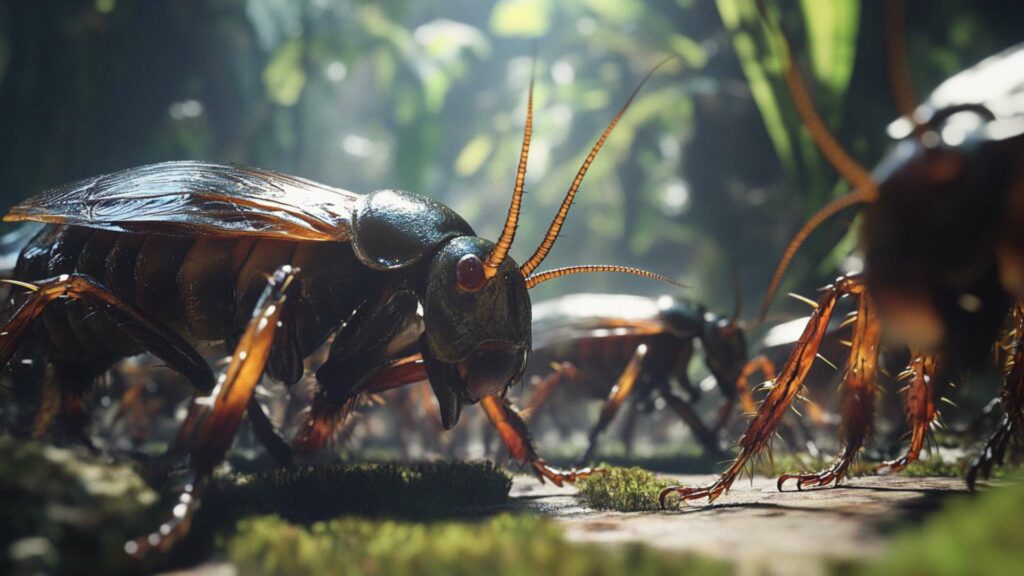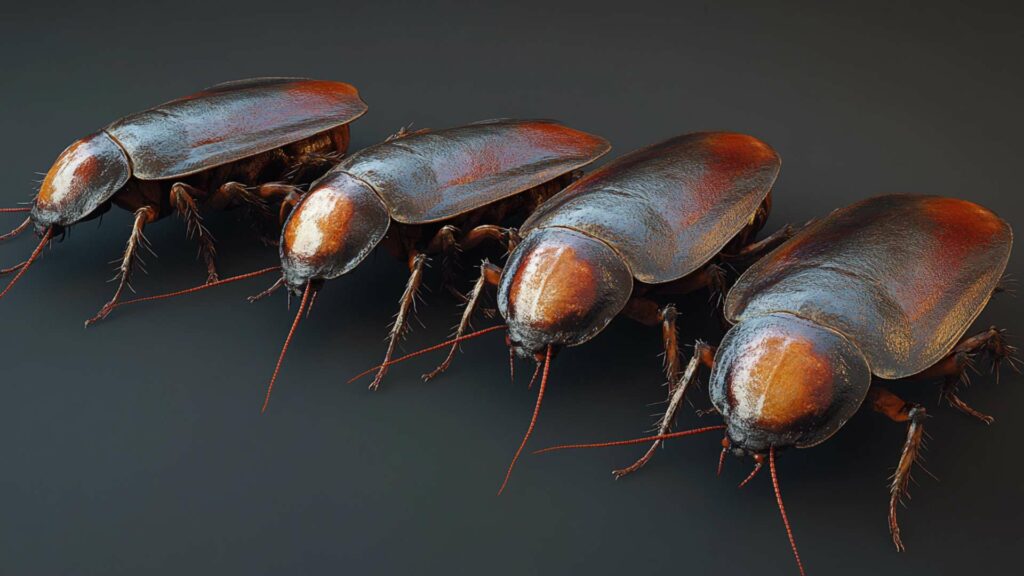Roaches, those creepy-crawly creatures that send shivers down our spines, are renowned for their ability to survive in the most challenging conditions. From extreme heat to freezing cold temperatures, these resilient insects have adapted and thrived for millions of years.
As winter approaches and temperatures drop, many wonder if roaches meet their demise or persist through the frigid months unscathed. In this article, we will explore the fascinating world of roaches and shed light on whether these robust insects die in the winter.
Myth vs. Reality: Roach Behavior Edition! Bust misconceptions and gain insights into roach habits in our article about roach interactions with substances and food.
Brief Overview of Roaches and Their Adaptability
Before diving into the topic at hand, it’s essential to understand a bit about roaches themselves. There are thousands of cockroach species worldwide, but two common ones often encountered are American cockroaches (Periplaneta americana) and German cockroaches (Blattella germanica).
While they may differ in appearance, both species possess remarkable adaptability traits that contribute to their survival. Roaches are nocturnal creatures with a distinct preference for dark, damp environments.
They possess an uncanny ability to squeeze into tight spaces, making them experts at hiding during daylight hours. Their flat bodies allow them to maneuver through cracks and crevices effortlessly – an adaptation honed over centuries of avoiding predators and finding safe havens.
Do Roaches Die in the Winter?

As winter looms on the horizon with its chilly winds and frosty mornings, it’s natural to wonder if roach populations dwindle or disappear entirely during this season. The answer is not as straightforward as one might think. While some factors influence their behavior during colder months, most cockroach species do not perish when temperatures plummet.
Cold temperatures do affect roach activity levels as their metabolic rate slows down. Roaches are ectothermic creatures, meaning their body temperature is regulated by the environment around them.
As winter sets in, they become less active and seek warm indoor spaces to survive the cold months. These cozy environments provide them with both shelter and access to potential food sources.
Roach Behavior in Cold Weather
Roaches seek warm indoor spaces during winter months. They become less active and slow down their metabolism.
During the winter season, roaches display several behavioral changes in response to the lower temperatures. While some species, such as the oriental cockroach, can tolerate colder conditions better than others like the German cockroach, most roaches still prefer seeking refuge indoors where it’s warmer.
This is why you might notice an increase in cockroach infestations during the winter months. Roaches are resourceful creatures that will exploit any opportunity to find a warm home.
They are adept at squeezing through small cracks, crevices, and openings in buildings to gain access to our cozy environments. Once inside, they gravitate towards damp areas such as kitchens and bathrooms where moisture levels tend to be higher.
These areas provide dead roaches with both warmth and a source of water for survival. As temperature drops, roaches become less active and slow down their metabolism significantly.
This reduced activity is an energy-saving mechanism that allows them to conserve resources during the colder months when food availability may be limited. It also makes them more elusive and harder to detect since they spend more time hiding in dark corners or within household structures like walls or attics.
So, do roaches die in the winter? While they don’t necessarily die off completely during this season, their behavior changes as they adapt to survive in our heated homes despite the cold temperatures outside.
Seeking shelter in cracks, crevices, and warm areas of buildings

During the winter months, when temperatures drop and the outdoors become inhospitable for most creatures, cockroaches employ various survival strategies to endure the cold. One such tactic is seeking shelter in the cozy confines of our homes and other buildings.
These resilient pests are experts at infiltrating the tiniest cracks and crevices to find refuge from the harsh conditions outside. They’re particularly skilled at locating hidden entry points around windows, doors, pipes, and utility openings.
Once inside a building, roaches waste no time in finding optimal hiding spots that provide both warmth and protection. They gravitate towards concealed areas such as walls, attics, basements, and crawlspaces where they can establish safe havens away from prying eyes — namely our own. These dark recesses provide cockroaches with an ideal environment resembling their natural habitats: damp areas with access to food sources like garbage or dirty dishes.
Squeezing into tight spaces to conserve heat
To survive during winter’s chillier periods when indoor temperatures might not be optimal for their survival either (as some species prefer extreme heat), roaches display remarkable adaptability by squeezing into even tighter spaces. By doing so, they can conserve body heat more efficiently while avoiding potential threats posed by humans or other predators.
This ability allows them to withstand colder temperatures for longer periods without succumbing to the elements. Roaches have developed ingenious ways to further survive temperatures throughout winter by capitalizing on human-made structures that offer warmth and protection.
By seeking shelter in cracks and crevices within buildings like walls or attics while also squeezing into tight spaces where they can conserve heat, these resilient pests manage to evade the harsh effects of cold temperatures. Despite their unwelcome presence in our homes, understanding their winter survival strategies can help us better prepare and take necessary measures to prevent roach infestations during this time of year.
Roach resistance to cold temperatures
Despite their reputation as hardy pests, roaches are not impervious to extreme weather conditions. However, many species of cockroaches possess remarkable physiological adaptations that allow them to survive lower temperatures during the winter months. These adaptations enable them to endure temporary exposure to freezing conditions and maintain their populations year-round.
Ability to survive freezing conditions for short periods
While most roaches prefer warm environments and seek shelter indoors during the colder months, some species can tolerate freezing temperatures for short periods without perishing. For instance, American cockroaches (Periplaneta americana) have been observed surviving in hibernation-like states in crawl spaces and other protected areas where temperatures occasionally drop below freezing.
During these inactive states, their metabolic rate drastically decreases, conserving energy until more favorable conditions arise. Moreover, certain cockroach species have developed mechanisms that allow them to withstand freezing conditions by producing antifreeze-like substances in their bodies.
These chemicals lower the freezing point of their bodily fluids, preventing ice crystal formation that could otherwise be lethal. By adapting in this way, they can endure harsh winter climates and resume normal activity once temperatures rise again.
While roaches may not die in the winter outright like some animals do during hibernation or torpor, they do exhibit adaptive behaviors and physiological traits that enable them to survive in colder environments. Understanding these survival strategies is crucial when dealing with a potential cockroach infestation during the winter months.
Cold snaps can reduce outdoor populations temporarily
During the winter season, temperature fluctuations have a significant impact on roach populations. Cold snaps, characterized by sudden drops in temperature, can lead to a temporary reduction in outdoor roach populations.
These cold spells cause many roaches to seek shelter and enter a hibernation-like state to survive the harsh conditions. As a result, their activity levels decrease significantly, and it becomes less common to spot them scurrying around.
Increased mortality rates among exposed roaches
When cold temperatures hit, exposed roaches are more likely to face increased mortality rates. While some species of cockroaches possess certain adaptations that allow them to tolerate lower temperatures for short periods of time, prolonged exposure can be lethal.
The colder it gets, the higher the risk becomes for these resilient pests. Additionally, freezing temperatures can cause damage to their bodies and internal organs if they are unable to find adequate shelter or warmth.
Moreover, extreme cold weather affects the reproductive capabilities of cockroaches. The decreased temperatures slow down their metabolism and interrupt their breeding cycles.
As a result, reproduction rates decline during periods of extreme cold. This disruption in their life cycle further contributes to the temporary reduction in population numbers during winter months.
Overall, although different species of cockroaches may have varying levels of resistance to cold temperatures, it is clear that winter has an impact on their populations. Cold snaps reduce outdoor populations temporarily as roaches seek shelter and enter hibernation-like states.
Increased mortality rates are observed among those exposed to chilly conditions while decreased reproduction rates occur when faced with extreme cold weather. Remember that prevention is key when it comes to avoiding cockroach infestations during winter months or year-round for that matter!
Indoor Infestations During Winter Months
Roaches Exploiting Human Habitats for Warmth and Resources
During the winter months, when cooler temperatures prevail, roaches are highly motivated to find warm and cozy indoor spaces. They are notorious for exploiting human habitats to fulfill their need for warmth and resources.
Unlike some other pests that hibernate or die off during the winter, roaches remain active, albeit at a slower pace as their metabolic rate slows down. While it’s true that extreme heat can be harmful to them, they possess remarkable survival instincts that help them persist year-round.
Increased Sightings and Activity Indoors
As the temperatures drop outside, it’s not uncommon to witness increased sightings and activity of cockroaches indoors. The warmth of residential and commercial buildings attracts these resilient creatures seeking refuge from the cold weather. Kitchens, bathrooms, and other warm areas become prime targets for roach infestations during winter due to the abundance of food sources and moisture availability.
When it comes to cockroach species commonly found in homes, both American cockroaches (Periplaneta americana) and German cockroaches (Blattella germanica) are known culprits in causing indoor cockroach infestations during winter months. These pests have adapted well to human environments and can reproduce rapidly under favorable conditions.
To tackle a potential cockroach infestation problem during winter, maintaining cleanliness is crucial. Dirty dishes left overnight can serve as an irresistible food source for these opportunistic insects.
Regular cleaning routines become even more essential in reducing their attraction towards your home. Additionally, sealing cracks and gaps around doors, windows, and foundation can prevent easy entry points for roaches seeking shelter.
Ultimately, dealing with a winter roach infestation may require assistance from pest control professionals who have extensive knowledge about different species of cockroaches such as the Oriental cockroach (Blatta orientalis). Their expertise can help identify the source of the infestation and implement effective pest control and measures to keep your home roach-free throughout the colder months.
Preventive measures against winter roach infestations
Sealing cracks and gaps around doors, windows, and foundation
Subtitle: Don’t let those sneaky critters find a way in! When the temperatures drop outside, roaches are on the lookout for warm and cozy spots to call home. To protect your abode from these unwelcome guests, it’s important to seal up any potential entry points.
Start by inspecting your doors and windows for gaps or cracks that may provide easy access. Weatherstripping can be a handy tool to block off these areas, ensuring that no chilly drafts or roaches can make their way indoors.
Don’t forget about your home’s foundation either! It’s not uncommon for cockroaches to squeeze through tiny openings in concrete or brickwork.
So take some time to carefully examine the exterior walls and seal up any gaps you may find using caulk or expanding foam. By fortifying these vulnerable areas, you’ll significantly reduce the likelihood of a winter roach invasion.
Regular cleaning routines to eliminate food sources

Subtitle: A clean house is an uninviting house for pests! Roaches are resourceful creatures with an insatiable appetite, so denying them access to food is key in keeping them at bay during winter months.
Establishing regular cleaning routines throughout your home becomes even more crucial when it comes to preventing infestations. Start with the heart of every household—the kitchen!
Roaches are particularly fond of dark corners and hidden crumbs around stoves, countertops, and cabinets. Keep countertops clear of food scraps by wiping them down regularly with a disinfectant cleaner.
Sweep or vacuum the floors diligently as well, paying special attention to hard-to-reach spaces like under appliances or along baseboards where crumbs tend to accumulate. Don’t forget about those often-forgotten areas where food can easily get trapped.
The kitchen sink and floor drains should be regularly sanitized and fitted with drain covers to prevent any tasty morsels from becoming a feast for roaches. By denying them easy access to food, you’re essentially closing down a gourmet restaurant for these pests, forcing pet food for them to seek sustenance elsewhere.
Reducing clutter that provides hiding spots
Subtitle: Out of sight, out of mind—until it’s too late! Cockroaches are masters at finding cozy hiding spots, especially in cluttered environments where they can comfortably set up camp.
To discourage their presence during winter, it’s crucial to declutter your living spaces. Start by tackling those piles of magazines or newspapers that have been collecting dust for months.
Roaches love the darkness and moisture often found in neglected reading materials. Dispose of any unnecessary papers or store them properly in sealed containers.
Next, turn your attention to those overlooked areas where clutter tends to accumulate—underneath beds, behind furniture, and inside closets. Take the opportunity to tidy up these spaces and prevent roaches from finding shelter in the nooks and crannies of your home.
Remember, reducing clutter not only deters roaches but also makes it easier for you to spot any potential signs of a roach infestation early on. It’s a win-win situation that will keep your entire house organized and pest-free throughout the winter months!
Recap of key points on roach survival during winter
Throughout this article, we have explored the fascinating world of roaches and their ability to adapt to various environments. When it comes to the question, “Do roaches die in the winter?” the answer is not a simple yes or no.
Most species of roaches do not die in the winter but instead find ways to survive low temperatures, that drop below freezing. Roaches exhibit various survival strategies during cold weather.
They seek warm indoor spaces, such as walls, attics, basements, and crawlspaces, where they can find shelter and a more suitable temperature. With their low metabolic rate during winter months, they become less active and conserve energy.
Emphasize the optimistic spin on the material
While it may be disconcerting to think about roaches finding their way into our homes during winter, understanding their behavior allows us to take preventive measures. By sealing cracks and gaps around doors, windows, and foundations, we can reduce their entry points.
Regular cleaning routines that eliminate food sources also discourage infestations. Remember that most roach species are found outdoors rather than indoors; therefore, encountering dead roaches indoors during winter is not necessarily an indication of an infestation.
If you happen to spot a few light reddish brown critters scurrying across your kitchen sink or near your water collection systems during colder months, it’s likely just a stray individual seeking warmth. While it’s true that roaches do not die in the winter like some other pests do, they can be managed effectively with proper knowledge and preventive measures.
If you’re concerned about a potential infestation or need assistance with pest control strategies tailored to your specific situation, reach out to a pest control professional who can provide expert guidance. With some simple precautions in place year-round and awareness of their behavior, we can ensure a peaceful coexistence with these resilient creatures in our homes.
D-Termination, Las Vegas’ Premier Pest Control, can eliminate cockroaches for you!

If you’re facing cockroach problems, don’t worry, as D-Termination is ready to assist. Our expert team specializes in eradicating cockroach infestations, restoring hygiene and peace of mind. Bid farewell to cockroaches—opt for D-Termination’s effective pest control today!
To book your cockroach control service and reclaim your space from these resilient pests, contact us at 702-919-6310 or visit dtermination.com.
Frequently Asked Questions:
Roaches can be more active during the summer due to warmer conditions.
To get rid of roaches in winter, use baits, traps, and seal entry points.
Roaches can die at temperatures below 0°C (32°F), but the exact temperature varies by species.
Roach infestations might be worse in warmer months, especially during spring and summer.








